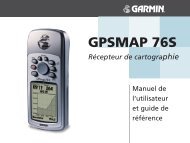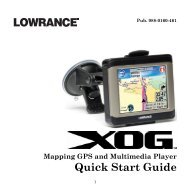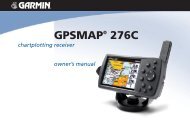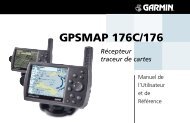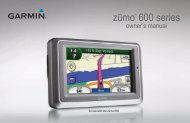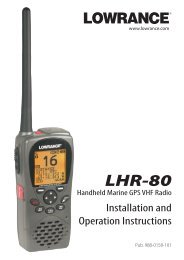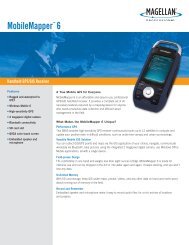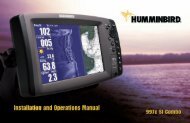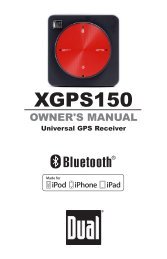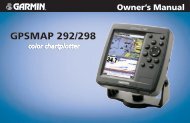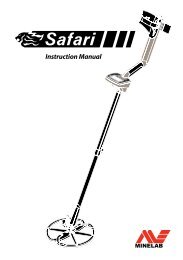X515C DF & X510C Manual - Lowrance
X515C DF & X510C Manual - Lowrance
X515C DF & X510C Manual - Lowrance
Create successful ePaper yourself
Turn your PDF publications into a flip-book with our unique Google optimized e-Paper software.
NOISE<br />
A major cause of sonar problems is electrical noise. This usually appears<br />
on the sonar's display as random patterns of dots or lines. In severe<br />
cases, it can completely cover the screen with black dots, or cause<br />
the unit to operate erratically, or not at all.<br />
To eliminate or minimize the effects of electrical noise, first try to determine<br />
the cause. With the boat at rest in the water, the first thing<br />
you should do is turn all electrical equipment on the boat off. Make<br />
sure the engine is also off. Turn your sonar on, then turn off Noise Reject<br />
[also known as the ASP feature (Advanced Signal Processing)].<br />
Sensitivity should be set at 90-95 percent. There should be a steady<br />
bottom signal on the display. Now turn on each piece of electrical<br />
equipment on the boat and view the effect on the sonar's display. For<br />
example, turn on the bilge pump and view the sonar display for noise.<br />
If no noise is present, turn the pump off, then turn on the VHF radio<br />
and transmit. Keep doing this until all electrical equipment has been<br />
turned on, their effect on the sonar display noted, then turned off.<br />
If you find noise interference from an electrical instrument, trolling<br />
motor, pump, or radio, try to isolate the problem. You can usually reroute<br />
the sonar unit's power cable and transducer cable away from the<br />
wiring that is causing the interference. VHF radio antenna cables radiate<br />
noise when transmitting, so be sure to keep the sonar's wires away<br />
from it. You may need to route the sonar unit's power cable directly to<br />
the battery to isolate it from other wiring on the boat.<br />
If no noise displays on the sonar unit from electrical equipment, then<br />
make sure everything except the sonar unit is turned off, then start the<br />
engine. Increase the RPM with the gearshift in neutral. If noise appears<br />
on the display, the problem could be one of three things; spark<br />
plugs, alternator, or tachometer wiring. Try using resistor spark plugs,<br />
alternator filters, or routing the sonar unit's power cable away from<br />
engine wiring. Again, routing the power cable directly to the battery<br />
helps eliminate noise problems. Make sure to use the in-line fuse supplied<br />
with the unit when wiring the power cable to the battery.<br />
When no noise appears on the sonar unit after all of the above tests,<br />
then the noise source is probably cavitation. Many novices or persons<br />
with limited experience make hasty sonar installations which function<br />
perfectly in shallow water, or when the boat is at rest. In nearly all<br />
cases, the cause of the malfunction will be the location and/or angle of<br />
the transducer. The face of the transducer must be placed in a location<br />
that has a smooth flow of water at all boat speeds. Read your transducer<br />
owner's manual or the Installation instructions (Sec. 2) in this<br />
manual for the best mounting position.<br />
115



